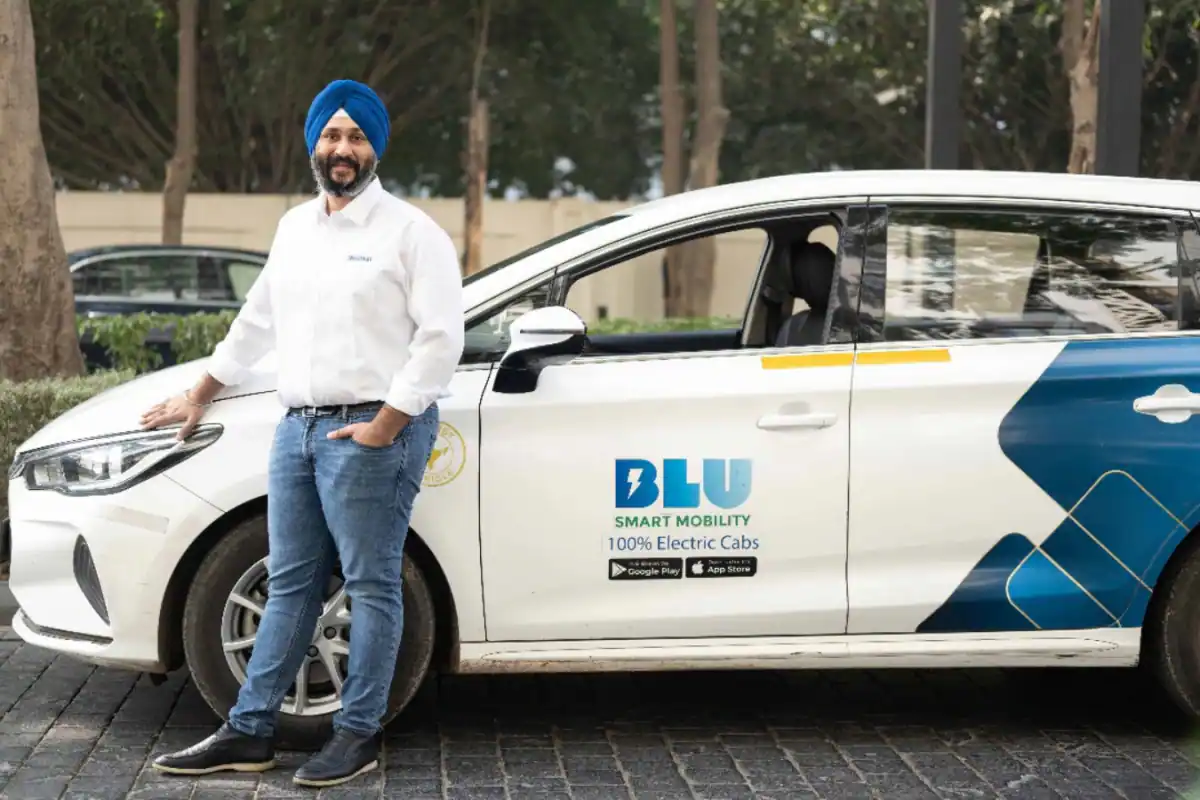In India’s push toward green mobility, BluSmart emerged as a bold player with an ambitious mission — to become South Asia’s first and largest all-electric ride-hailing service. Launched in 2019, the startup aimed to decarbonize urban transport and eliminate the unpredictability of traditional ride-sharing platforms like Ola and Uber. With a clean, tech-driven approach, BluSmart was seen as the future of Indian commuting.
But by 2025, that future came to a screeching halt.
The Rise: Green Promises and Tech Innovation
Co-founded by Anmol Singh Jaggi and Puneet Singh Jaggi, BluSmart began operations in Delhi-NCR with a fleet of electric vehicles (EVs) and a promise of zero surge pricing and zero emissions. Unlike competitors who relied on gig workers and driver-owned vehicles, BluSmart took full ownership of its EV fleet and directly employed trained drivers — a model that gave it operational control and a consistent customer experience.
BluSmart quickly became a favorite among climate-conscious urban commuters. Backed by major investors like BP Ventures, and supported by partnerships with Mahindra Electric and Jio-bp, the company scaled operations in Delhi and Bengaluru, setting up its own charging infrastructure to support its expanding fleet.
Technology played a key role. Leveraging Google Cloud and AWS, BluSmart deployed real-time analytics, predictive maintenance, and AI-based routing to boost operational efficiency. The company’s tech-led operations and environmental promise created strong media buzz, brand loyalty, and investor enthusiasm.
The Fall: From Disruption to Dysfunction
Despite the early wins, trouble had been brewing behind the scenes. By early 2024, financial red flags started to emerge — delayed salaries, unpaid vendor dues, and reports of cash flow problems.
As BluSmart expanded, its asset-heavy model began showing strain. Owning EVs and building charging infrastructure demanded massive capital outlay, while operational costs ballooned. Unlike asset-light competitors, BluSmart couldn’t offset costs fast enough with ride revenues. The startup became increasingly dependent on funding — a risky bet in a tightening investment climate.
Fraud Allegations and Internal Turmoil
The turning point came in 2025 when allegations of financial mismanagement and fraud surfaced. Whistleblowers and former employees accused the leadership of embezzlement, inflated billing, and misuse of grant funds. Auditors reportedly raised concerns, and lawsuits followed. Government agencies began investigating.
Trust — BluSmart’s most valuable intangible asset — eroded quickly. Investors pulled out, vendors terminated contracts, and the media spotlight intensified.
Shutdown and Fallout
By mid-2025, BluSmart stopped paying employee salaries and defaulted on major payments. Operations ceased in September, shocking customers, employees, and the broader EV ecosystem. Charging stations were abandoned, drivers were left in limbo, and public backlash poured in.
A company once hailed as a pioneer of clean mobility had come undone.
Why BluSmart Failed: Key Factors
1. Capital-Intensive Model
Owning fleets and charging hubs requires heavy investments. Without steady income or external funding, BluSmart’s cost structure became unsustainable.
2. Weak Governance
Lack of internal controls and financial transparency allowed alleged misconduct to go unchecked. Investors and regulators lost confidence.
3. Overambition, Underdelivery
Rapid expansion without a strong financial cushion left the company vulnerable to any disruption in revenue or funding.
4. Erosion of Trust
Once fraud allegations surfaced, stakeholders distanced themselves quickly. In today’s digital age, reputation damage spreads fast and deep.
5. Competitive Pressure
While BluSmart focused on green innovation, giants like Ola Electric and Uber Green quickly replicated similar offerings, often with stronger funding and reach.
Lessons for Indian Startups
BluSmart’s rise and fall is a stark reminder that innovation alone isn’t enough. To scale sustainably, startups must focus equally on governance, financial discipline, and ethical practices.
- Transparency and accountability are non-negotiable — especially when handling public funds, subsidies, or investor money.
- Asset-heavy models can work, but they need robust financial planning and operational excellence.
- Trust — with customers, employees, and investors — is a startup’s biggest asset. Once lost, recovery is difficult.
Conclusion: A Dream Cut Short
BluSmart entered the market with a powerful idea and the right timing. It solved real pain points with sustainability at its core. But the inability to balance ambition with execution, combined with ethical lapses, ultimately led to its downfall.
Its journey serves as a cautionary tale for India’s startup ecosystem: building the future requires more than innovation. It needs resilience, responsibility, and integrity — especially when you’re driving change in high-stakes, capital-intensive sectors like electric mobility.
